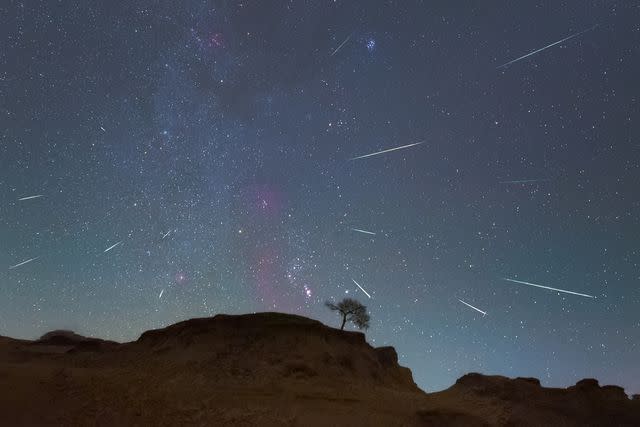This Meteor Shower Lights Up the Sky Every Year Thanks to Halley's Comet — and You'll Be Able to See It Tonight
Stay up late for a spectacular sight in the sky!
The aurora borealis isn’t the only marvel lighting up this month’s night sky. Between Oct. 21 and 22, the Orionids meteor shower will peak, sending roughly 15 meteors per hour across the northern and southern hemisphere skies. According to NASA, speed and brightness are trademarks of this annual October meteor shower.
As always, a dark stargazing getaway with limited light pollution provides the best odds to catch this interstellar attraction. Here's everything you need to know for the Orionids meteor shower including how to to plan your viewing experience — from where to go and to what to bring.

Costfoto/Future Publishing/Getty Images
What is the Orionids meteor shower?
The “shooting stars” we see during the Orionids meteor shower are actually space dust and ice crystals that stem from Halley’s Comet. This well-studied comet appears near Earth roughly every 75 years. While we won’t see Halley’s Comet again until 2061, we can enjoy its annual October byproduct: the vibrant and speedy Orionids meteor shower, which sees meteor speeds of up to 148,000 miles per hour, according to NASA.
When can I see the Orionids meteor shower?
The full Orionids meteor shower runs from late September through Nov. 22, 2022. According to NASA, peak activity hits from Oct. 21 to 22 this year. The Orionids are visible after midnight in both the northern and southern hemispheres. This year’s timing is particularly ideal for viewing, as the moon will be a waning crescent; that means minimal moonlight obstructing those inky-black skies.
How can I see the Orionids meteor shower?
You don’t need a telescope or binoculars to see the Orionids meteor shower. Instead, find a place with dark skies — here are some of our favorites — and look for viewing areas with minimal overhead obstructions (i.e., open plains versus thick forests). The wider your viewing area, the greater your chance of meteor sightings.
Don’t get discouraged if you don’t see soaring meteors from the get-go. It can take your eyes up to 30 minutes to adjust to the dark. In addition to low light pollution, clear skies with minimal clouds are critical for meteor shower visibility.
For more Travel & Leisure news, make sure to sign up for our newsletter!
Read the original article on Travel & Leisure.

